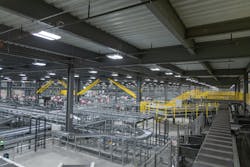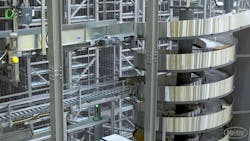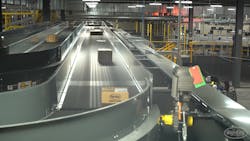Enabling the Factory of the Future
At a Glance:
- Automation is an equalizer and is spawning a rapidly growing trend that’s advancing the use of robots to smaller factories.
- Manufacturers using Robotics as a Service (RaaS) gain the benefits of robotic process automation by leasing robotic devices and accessing a cloud-based subscription service rather than purchasing the equipment.
- Digi-Key’s state-of-the-art distribution facility, the new Product Distribution Center Expansion (PDCe), is held up as a prime example of a factory of the future.
As demand for smarter, safer and more efficient manufacturing continues to rise, advanced automation is answering the call, transforming the factory floor of tomorrow, and leading to a high level of consistency and reliability in products. Expedited by the COVID-19 pandemic, demand has spurred a cultural shift among manufacturers leading towards accelerated adoption of new technologies
From smart sensors to smart edge devices and cloud infrastructure, the impact that the Industrial Internet of Things (IIoT) has had on the manufacturing industry cannot be understated. IIoT enables more intelligent, predictive and proactive processes that lead to enhanced overall efficiencies.
Here’s a closer look at the smart manufacturing technologies that are revolutionizing the future of factories for the better.
Cobots
We have now reached a point where, as a society, we are less afraid of robots or automation “taking away” human jobs because we’ve realized the immense benefits to be gained. It’s generally accepted that robots that work in tandem with humans—collaborative robots (cobots)—have huge potential for keeping workers safe and happy.
Reassigning tedious and/or repetitive tasks to a robot can shift the average manufacturing position to one that is more decision-based than task-oriented, as in the past. Humans can take on projects that require judgment calls or creativity, leaving heavy lifting and/or less-engaging work to robotics—therefore improving safety and reducing injuries.
Furthermore, while these robots are very complex machines, it often does not require a degree in computer science to learn how to re-program them to do more than one task. It’s common now to see more “general purpose” robots with computer vision that can adapt to different environments and quickly be re-programmed to serve more than one function.
Many leading companies are automating processes today, and we very much expect that to trickle down to many more companies in the near future. Tesla is one example of a factory that is really embracing automation and optimizing their processes. Apple has contracted out the recycling of their iPhones to a factory where robots disassemble the retired phones. They’re able to recycle some of the parts and retrieve some of the precious metals inside, with robots doing reverse assembly and keeping workers safe from heavy metals and repetitive labor.
Overall, this is improving morale, reducing stress and increasing job satisfaction amongst workers—something that is increasingly important at a time when labor is particularly tight: job openings in the manufacturing industry are more than twice as high as they were in the past couple of years, according to the U.S. Labor Department. Human workers being assisted by robots will also be safer, with less injuries, accidents and repetitive stress-type injuries.
READ MORE: Making Automation Easy Starts With the Design Process
Robotics as a Service
Automation is an equalizer and is spawning a rapidly growing trend that’s advancing the use of robots to smaller factories. In fact, the global robotics as a service (RaaS) market was valued at $12.6 billion in 2020 and is expected to surpass $41.3 billion by 2028, according to a recent report published by Coherent Market Insights.
Like software as a service (SaaS), manufacturers using RaaS get the benefits of robotic process automation by leasing robotic devices and accessing a cloud-based subscription service rather than purchasing the equipment. With RaaS, manufacturers can avoid paying for an expensive piece of equipment, handling maintenance and other headaches of full-on ownership. Manufacturers can simply contact a company that supplies RaaS and have them set up the entire automation at a fraction of the price of purchasing and owning their own robotic devices.
There is so little that can’t be automated at this point, and it’s typically a matter of whether the cost to automate will be prohibitive to doing the automation. As these costs continue to decrease, this will allow for a resurgence of manufacturing in Western Europe and in North America—we expect a lot more regional manufacturing to come about in the next five to 10 years. Automation is very much an equalizer; the robotics machine has costs to run no matter where it is, but you’re not paying human labor costs for those repetitive processes.
Another RaaS trend is the “digital twin,” where a factory or production cell is recreated in a virtual environment using the specifications of exact products, or in some cases, having the system dictate which products should be used. Users can simulate manufacturing an product in a digital environment and learn ways to optimize the placement of machines and optimize material flow.
Digital twins can also alert factory operators and managers when a motor is going to start running out, or when they should expect maintenance. Running the digital twin can solve many problems before they occur. A RaaS provider and integrator can help create the digital twin and help figure out the processes to accomplish stated goals.
Edge Computing
The factory of the future will be home to a huge number of sensors which gather an immense amount of data. The expense of communicating that data back to the cloud is both slower and more costly than processing it closer to the source—at the edge.
For example, a continuous temperature monitoring system at the edge may be able to analyze the data it is processing and send an alert or notification when there is an out-of-the-ordinary temperature level. This allows for much faster data analysis, and ultimately faster action, as there is no need to wait for the data to be sent to the cloud.
New connectivity options such as Long Range Wide Area Networks (LoRaWAN) are enabling edge computing at a much faster rate in the manufacturing industry, making it an effective and efficient connectivity option for data analysis in factories.
READ MORE: Designing a Turnkey Vision-Guided Bowl Feeder Cell
Artificial Intelligence
Machine-to-machine communication through wireless connectivity can now communicate with edge computers to provide analysis of processes. Through machine learning, changes can be made through minimal programming, allowing factories to continuously adjust their processes and continue to increase efficiency.
Artificial intelligence (AI) applications can unlock the true potential of IoT and edge applications across manufacturing and the factory floor. With real-time analytics, connected sensors, predictive maintenance, supply chain automation and other process advancements, the manufacturing industry is quickly being propelled into a new era.
Similarly, distributors such as Digi-Key are also leveraging this technology to stock shelves to automate the world’s largest selection of electronics components and facilitate signature shipping speeds.
The Future Digi-Key Factory
Digi-Key’s state-of-the-art distribution facility, the new Product Distribution Center Expansion (PDCe), is a prime example of a factory of the future. Set to be fully operational later in 2022, it is one of the largest distribution facilities in the world at 1 million square feet. The PDCe clocks in at 2.2 million square feet of multi-level distribution space. The center will house all of Digi-Key’s order fulfillment operations, including picking, packing and shipping, as well as the receiving of product and overflow pallet storage.
The built-in technology of this facility includes 27 miles of high-speed, automated conveyor belt that will allow for the brains of the operation—the Order Storage Retrieval, or OSR system—to automatically retrieve product and prepare orders to be packed. The OSR supports a goods-to-person fulfillment order using 1,000 automated shuttles that can move throughout the OSR and store up to 2.7 million unique parts.
This intelligent, automated system will allow for orders to be picked, packed and shipped much faster, and eliminate wasteful packaging with orders being shipped in multiple boxes. It will also free up warehouse workers to take on new responsibilities in the warehouse, as well as increase their safety and eliminate a significant amount of manual labor.
The facility features many other innovations, including a garbage-picking robot that will empty more than 400 garbage cans located throughout the facility. In this setting, the robotics and the automated systems will not eliminate any jobs, but instead provide opportunities for the current workforce to apply or expand their skills in other areas of the warehouse.
READ MORE: 6 Amazing Ways IoT is Shaping Trucking for the Long Haul
What’s Ahead
One area of potential is in reshoring manufacturing jobs and making them more local and flexible. In the coming five to 10 years, the increased number of robots and other technologies could make mass customization, lot sizes of one and regionalized manufacturing a reality. Rather than a factory being dedicated to making a million of one item, perhaps a factory could be dedicated to making items that fit exact customer needs.
For example, a customer could upload a photo or 3D model of themselves to a local factory via the cloud, which a robot could use to manufacture a shirt from start to finish that fits their exact measurements. The shirt may then be delivered to the customer in just a day or two because it does not have very far to travel—a significant improvement on the current model of mass production, where orders are often shipped overseas before reaching the customer.
This would help eliminate some of the wasteful aspects of manufacturing across the entire supply chain—wasted resources, lengthy shipping routes and returns—making the entire process more individualized and less resource-intensive. Even the giant factory buildings could fade away in the near future as factories become smaller, more flexible and localized, with robots learning and adapting as they go.
Despite significant advancements, we haven’t yet scraped surface when it comes to the intersection of robotics and artificial intelligence. Manufacturing as we know it will be completely different over the course of the next 10 years—thanks in large part to the industry’s digital transformation and the benefits it promises to bring.
Robbie Paul is director of IoT business development for Digi-Key Electronics, which recently produced a Factory Tomorrow video series that you can view here.



